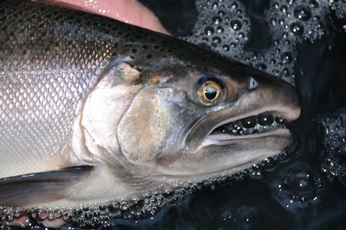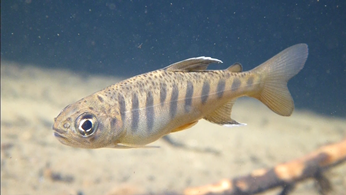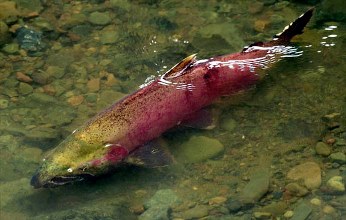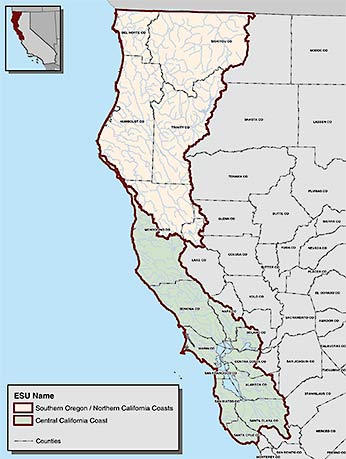Oncorhynchus kisutch
Identification
 Figure 1: Adult Coho Salmon showing white gums. CDFW photo.
Figure 1: Adult Coho Salmon showing white gums. CDFW photo.
Coho Salmon Oncorhynchus kisutch are a medium to large salmon, with spawning adults typically measuring 55 to 70 cm fork length and weighing from 3 to 6 kg (Moyle 2002). Spawning males are characteristically dark red on the sides, with the head and back dark green and the belly gray to black. Females are less colorful than males and often appear dull in comparison, with dark pink on the sides.
Most spawning males are characterized by a hooked jaw and slightly humped backs. The jaw is less hooked in jacks (2-year olds) and only very slightly hooked in females. Both sexes have small black spots on the dorsal (back) fin and upper lobe of the caudal (tail) fin, with no spots on the lower lobe of the caudal fin. The gums of the lower jaw are usually gray, except for the upper area at the base of the teeth, which is white (Figure 1).
 Figure 2: Juvenile Coho Salmon. CDFW photo by Derek Acomb.
Figure 2: Juvenile Coho Salmon. CDFW photo by Derek Acomb.
Coho salmon parr (juveniles) have 8-12 narrow parr marks centered along the lateral line. The parr marks are narrow and widely spaced. The top half of the body is spotted and the adipose fin is finely speckled, giving it a gray or dusky color. The other fins lack spots and are usually tinted orange. The anal fin is pigmented between the rays, often producing a black and orange banding pattern. The anal fin is also described as large and sickle-shaped, with a white leading edge, which along with the large eyes, distinguishes them from other juvenile Salmonids (Figure 2).
Threats
California Coho Salmon have been in serious decline since the mid-20th century. The causes of these declines are largely human related and are multiple and interacting but can be divided into four broad categories: (1) loss of suitable habitat, (2) interaction with hatchery fish, (3) overexploitation and (4) climatic factors, such as oceanic conditions and precipitation (Brown et al. 1994). Human activities implicated in the decline of Coho Salmon in California include commercial overfishing of ocean stocks and loss and degradation of suitable freshwater and estuarine habitats. This occurred through land and water developments associated with agriculture, forestry, gravel mining, urbanization, water supply, and river regulation (CDFG 2004, Moyle, 2002).
In the early 1990’s, declining populations prompted the closure of all commercial and recreational fisheries for Coho Salmon in California. This was soon followed by the listing of California Coho Salmon under both the California Endangered Species Act (CESA) and the Federal Endangered Species Act (ESA), actions which afforded the species an increased level of protection, but which have so far not prevented the on-going population declines.
Distribution and Habitat
Historically, Coho Salmon were widely distributed and abundant in many coastal watersheds of central and northern California, ranging from the Smith River near the Oregon border to the San Lorenzo River, Santa Cruz County, on the central California coast.
However, over recent years the distribution and abundance of Coho Salmon populations in California have been considerably reduced. Although Coho Salmon are still found in most major river systems in the northern portion of the state, many spawning runs have declined substantially in size and were eliminated from many tributaries, including some streams in the Klamath and Eel River basins.
Overall, from Humboldt County north to the Oregon border, Coho Salmon are now found in approximately two-thirds of the streams identified as historical habitat. In the southern part of their range, Coho Salmon are now absent from all tributaries of San Francisco Bay and many streams south of the Bay; this is likely associated with adverse effects from increased urbanization and other human developments on watersheds and fish habitat (CDFG 2004).
California Coho Salmon typically inhabit small coastal streams, as well as larger rivers, such as the Klamath River system, where they are currently found as far upstream as Iron Gate Dam and the Shasta River. Coho Salmon in northern California coastal streams are typically associated with low gradient reaches of tributary streams, which provide suitable spawning areas and good juvenile rearing habitat. Brown and Moyle found historical records of occurrence of Coho Salmon in 582 California streams, ranging from the Smith River to the Big Sur River on the central coast, but by 1991 had been lost from about half these streams (Moyle 2002).
Spawning and Egg Development
Adult Coho Salmon enter fresh water to spawn from September through January. In the short coastal streams of California, migration usually begins between mid-November and mid-January. Coho Salmon move upstream after heavy rains open the sand bars that can form at the mouths of many California coastal streams, but may enter larger rivers earlier.
Generally, Coho Salmon spawn in smaller streams than do Chinook Salmon. In California, spawning occurs mainly from November to January, although it can extend into February or March. In the Klamath and Eel rivers, spawning usually occurs in November and December. Females usually choose spawning sites near the head of a riffle with medium to small gravel substrates. Females dig redds (nests) by turning partly on their side. Using powerful, rapid movements of the tail, gravels are dislodged and transported a short distance downstream by the current. Repeating this action creates an oval-to-round depression at least as deep and as long as the fish. Eggs and milt (sperm) are released into the redd, where, because of the hydrodynamics of the redd, they tend to remain until they are buried.
Approximately one-hundred or more eggs are deposited in each redd at any one time. The fertilized eggs are buried by gravel as the female digs another redd just upstream, and the process is then repeated. Spawning takes about one week during which time the female deposits a total of between 1,000-3,000 eggs (Moyle 2002). The stream flow characteristics of the redd location usually ensure good aeration of eggs and embryos and the flushing of waste products.
In California, eggs incubate in the gravels from November through April. The incubation period is inversely related to water temperature. California Coho Salmon eggs hatch in about 48 days at 48°F, and 38 days at 51.3°F. After hatching, the alevins (hatchlings) are translucent in color. This is the most vulnerable life stage, during which they are susceptible to being buried in silt, freezing, gravel scouring and shifting, desiccation due to redd exposure, and predation. Alevins remain in the interstices of the gravel for two to ten weeks until their yolk sacs are absorbed, at which time their color changes to that more characteristic of fry. The fry are silver to golden with large, vertical, oval, dark parr marks along the lateral line that are narrower than the spaces between them.
Fry and Juvenile Development
Fry emerge from the gravel between March and July, with peak emergence occurring from March to May, depending on when the eggs were fertilized and the water temperature during development. They seek out shallow water, usually moving to the stream margins, where they form schools. As the fish feed heavily and grow, the schools generally break up and individual fish set up territories. At this stage, the fish are termed parr (juveniles). As the parr continue to grow and expand their territories, they move progressively into deeper water until July and August, when they inhabit the deepest pools. This is the period when water temperatures are highest and growth slows. Food consumption and growth rate decrease during the winter months of highest flows and coldest temperatures (usually December to February). By March, parr again begin to feed heavily and grow rapidly.
 Coho Salmon Adult Male. CDFW photo by Mike Dean.
Coho Salmon Adult Male. CDFW photo by Mike Dean.
Typical rearing areas used by juvenile Coho Salmon include low-gradient coastal streams, sloughs, side channels, alcoves, estuaries, low-gradient tributaries, large rivers, beaver ponds, and large slack waters. The most productive juvenile habitats are found in smaller streams with low-gradient alluvial channels containing abundant pools formed by large woody debris. Adequate winter rearing habitat is important to successful completion of Coho Salmon life history and, due to agricultural land development and other human activities, is often lacking in many California coastal streams.
Smolt Emigration and Ocean Rearing
After one year in fresh water, Coho Salmon smolts begin migrating downstream to the ocean in late March or early April. In some years emigration can begin prior to March and can persist into July. Peak downstream migration in California generally occurs from April to early June. Factors that affect the onset of emigration include fish size, flow conditions, water temperature, dissolved oxygen levels, day length, and food availability. Low stream productivity due to low nutrient levels or cold water temperatures, can contribute to slow growth, potentially causing Coho Salmon to postpone emigration. There may be other factors that contribute to a freshwater residency of longer than one year, such as late spawning, which can produce fish that are too small at the time of smolting to migrate to sea.
 SONCC and ESU's and boundaries CDFG 2004. (click to enlarge)
SONCC and ESU's and boundaries CDFG 2004. (click to enlarge)
The amount of time Coho Salmon spend in the river estuary prior to entering the ocean is variable and is often less in the southern portion of their range. Upon entry into the ocean, immature Coho Salmon remain in inshore waters, congregating in schools as they move north along the continental shelf. Most remain in the ocean for two years; however, some return to spawn after the first year, when they are referred to as grilse or jacks. Data on ocean distribution of California Coho Salmon are sparse, but it is believed that the Coho Salmon scatter and join schools from Oregon and possibly Washington.
Species Status
In 1995, the California Fish and Game Commission issued a finding that Coho Salmon south of San Francisco to Monterey Bay warranted listing as endangered under CESA. In March 2005, Coho Salmon were listed as a threatened species from the Oregon border south to Punta Gorda and as an endangered species from Punta Gorda south to San Francisco, including the Bay.
Evolutionarily Significant Units (ESUs) are defined by NOAA under the ESA. California Coho Salmon are divided into two ESUs, the Central California Coast ESU (CCC ESU) and the Southern Oregon/Norther California ESU (SONCC ESU).
The CCC ESU Coho Salmon was initially listed as a threatened species on October 31, 1996 of the ESA and up-listed under the ESA from “threatened” to “endangered,” effective June 28, 2005. This ESU includes naturally-spawned Coho Salmon originating from rivers south of Punta Gorda, to and including Aptos Creek, as well as Coho Salmon originating from San Francisco Bay tributaries. It also includes Coho Salmon originating from two artificial propagation programs:
- Coho Salmon Recovery Program located at Don Clausen Fish Hatchery (otherwise known as Warm Springs Hatchery) on Dry Creek in Sonoma County; and
- Scott Creek Coho Salmon Program, located at Kingfisher Flat Conservation Hatchery. This program consists of the Monterey Bay Salmon and Trout Project and the Coho Salmon Captive Broodstock Program at the NOAA Southwest Fisheries Science Center in Santa Cruz.
The SONCC ESU Coho Salmon was listed as threatened under the ESA on May 6, 1997. This ESU includes all Coho Salmon populations from Cape Blanco, Oregon to Punta Gorda, California. On June 28, 2005, the National Marine Fisheries Service (NMFS) subsequently included ESA protections to hatchery-raised Coho Salmon produced at Iron Gate Hatchery, Trinity River Hatchery, and Cole M. Rivers Hatchery in Oregon as part of the SONCC ESU.
The National Marine Fisheries 2016 viability assessment of the SONCC ESU found that the ESU status under the ESA is likely to move from threatened to endangered status. For the CCC ESU, the risk of extinction has increased since the species was listed as endangered under ESA in 2005 (Spence and Williams 2011).
Recovery Strategy
The Recovery Strategy for California Coho Salmon (94 MB PDF Download) (Recovery Strategy) was adopted by the California Fish and Game Commission in February 2004. The primary objective of the Recovery Strategy is to return Coho Salmon to a level of sustained viability while protecting the genetic integrity of both the SONCC and CCC ESUs with the goals of delisting, thus making regulations or other protections under the CESA and ESA no longer necessary. A second objective of this Recovery Strategy is to achieve harvestable populations of Coho Salmon for tribal, recreational, and commercial fisheries (CDFG 2004).
Recovery projects implemented in California’s coastal watersheds include; (1) restoration and enhancement of suitable habitat conditions for juveniles and adults, (2) Improvements in permitting and regulatory enforcement to protect Coho Salmon populations and their habitats, (3) continuation and further development of captive rearing programs at Warm Springs and Kingfisher Flat conservation hatcheries to help re-establish Coho Salmon in depleted streams north and south of San Francisco Bay, respectively, and (4) implementation of range-wide and watershed-wide recommendations identified in the Recovery Strategy.
Consultation and partnerships with other agencies, organizations and stakeholders is essential to Coho Salmon recovery. In addition to the State Recovery Strategy, Federal recovery plans for both the CCC and SONCC ESUs, which extend and build upon the earlier State Recovery Strategy, were recently prepared by the NMFS (2012 and 2014).
It is hoped that when fully implemented, the State and Federal Recovery Plans will eventually result in the complete recovery of California Coho Salmon, although due to the depleted nature of most populations, this may take considerable time.
References
- Brown, L. R. and P. B. Moyle. 1991. Status of coho salmon in California report to the National Marine Fisheries Service. Department of Wildlife and Fisheries Biology, University of California, Davis.
- Brown, L. R., P. B. Moyle, and R. M. Yoshiyama. 1994. Historical decline and current status of coho salmon in California. Department of Wildlife and Fisheries Biology, University of California, Davis.
- California Department of Fish and Game. 2004. Recovery Strategy for California Coho salmon. Report to the California Fish and Game Commission.
- Moyle, P.B. 2002. Inland Fishes of California, University of California Press.
- NMFS. 2012. Final Recovery Plan for Central California Coast Coho Salmon Evolutionarily Significant Unit. NMFS, Southwest Region, Santa Rosa, California.
- NMFS. 2014. Final Recovery Plan for the Southern Oregon/Northern California Coast Evolutionarily Significant Unit of Coho Salmon (Oncorhynchus kisutch)
- Spence. B.C. and T.H. Williams. 2011. Status Review update for Pacific Salmon and steelhead listed under the Endangered Species Act: Central California Coast Coho Salmon ESU. NOAA Technical Memorandum, National Marine Fisheries Service, Pg. 12.
- Williams, T.H., B.C. Spence, D.A. Boughton, R.C. Johnson, L.G. Grozier, N.J. Mantua, M.R. O’Farrell, and S.T. Lindley. 2016. Viability assessment for Pacific Salmon and steelhead listed under the Endangered Species Act: Southwest. U.S. Department of Commerce, NOAA technical Memorandum NMFS-SWFSC-564.
Dr. Stephen Swales, CDFW
Statewide Coho Salmon Recovery Coordinator,
Stephen.Swales@wildlife.ca.gov
News
Permitting Alternatives for Small Restoration Projects
Grant Funding
Conservation Programs